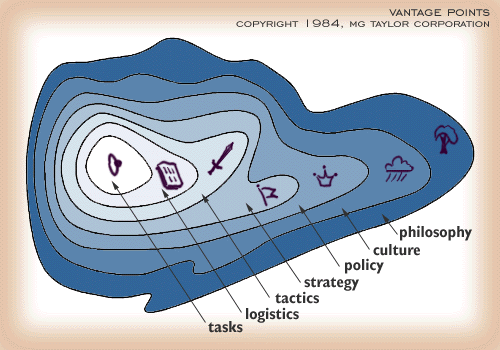
|
|
Based on a model developed by Thomas Gilbert in the book Human Competence, published in 1978. Like the other models of the MG Taylor Modeling Language, the Vantage PointsModel is protected by copyright. You can use it only by meeting these four conditions. The Vantage Points model looks like a topographic map with the boundary between each vantage point representing a contour line. The question for all of you budding cartographers out there--is it a map of a mountain or a depression? Is the Tasks vantage point the peak of the mountain or the bottom of a pit?
The View From TaskDespite the technicality, it's useful to think of the model as both a mountain and a pit (or a lake). In a way, you can never understand the philosophy of a system or enterprise until you are immersed in the tasks that comprise its daily functions. The task provides a mental elevation from which the whole essence of the system can be contemplated. The philosophy and culture of an organization will be expressed in the way an associate is taught or allowed to perform its tasks. By observing people performing various tasks, by sensing the atmosphere, energy and ethics of the environment, most anyone can determine the true expressed philosophy of any organization. I remember waiting in a department store for 15 minutes for service, while one employee (who was watching me off and on) completed what was obviously a casual personal phone call and the other informed me she was going on a coffee break. Intrigued, and being in no hurry, I amused myself in the meantime by timing the event and reading the mission statement on customer service that hung on the wall. On the other hand, sometimes immersion in daily tasks can blind people to culture and philosophy, or cause them to accept it too casually. Many of our actions are based on essentially hidden stimuli and barely understood themes. "It's just the way we do things in this town." The models that make up our philosophy are usually accepted as truth and fact, and any threat to their veracity may be hotly contested on no other basis than precedent behavior. Models are ingrained in this way for a purpose. Most of us can't spend all of our time evaluating various philosophies; it's easier to accept one and act out from it. This avoids confusion and allows cultures and teams to consolidate or condense. It allows each of us to belong to something. The liability of such a phenomenon, however, should be clear. Philosophies accepted as truth are very hard to shake or adapt to changing circumstances. Philosophies accepted as models can be mastered, evaluated, and exchanged based on experience and exploration [see the 5 E's model] Designing and Managing with the Vantage PointsLike all of the MG Taylor models the Vantage Points are meant to be managed and designed--used as templates and auditing tools. The Vantage Points break down into three overlapping zones for special types of management emphasis.
Most enterprises are used to tightly managing tactics, logistics and tasks. Policy manuals in particular are aimed at these three levels (although Policy manuals should be aimed at all of the other vantage points including managing the evolution of philosophy and culture). Companies that undertake formal, structured or systematic forms of broad-based planning manage the strategy level. However, little attention is usually paid to managing and designing culture or philosophy (with some notable exceptions). This is not to say that many people don't talk about culture or philosophy or about changing both. The seven Vantage Points do hold mutual, feedback-driven influence over one another. It is possible to change Philosophy by innovating Tasks or Logistics. In fact, it's rather foolish to make a statement changing philosophy or culture and expect the change to establish itself without commensurate changes at all of the other levels of the model. Nevertheless, it is more difficult for tasks to influence philosophy than visa versa. This is due to the hidden power of philosophy discussed in preceding paragraphs, and the need for organizations to hold a standard core of commonality in order for their identity to stay intact. Here's a quick definition of each of the vantage points:
Here's another idea for a Personal Journal page: Copyright © 1996, MG Taylor Corporation.
All rights reserved 19961104211833.web.bsc |
|
Copyright,
|
iteration
3.5
|








 Mapmakers and map readers alike know that contour lines
indicating depressions are all marked with special tick marks that point in
the direction of the downward slope. So technically, the Vantage Points model
translated into a topographic map represents a mountain or hill with the Tasks
vantage point at its summit.
Mapmakers and map readers alike know that contour lines
indicating depressions are all marked with special tick marks that point in
the direction of the downward slope. So technically, the Vantage Points model
translated into a topographic map represents a mountain or hill with the Tasks
vantage point at its summit.











